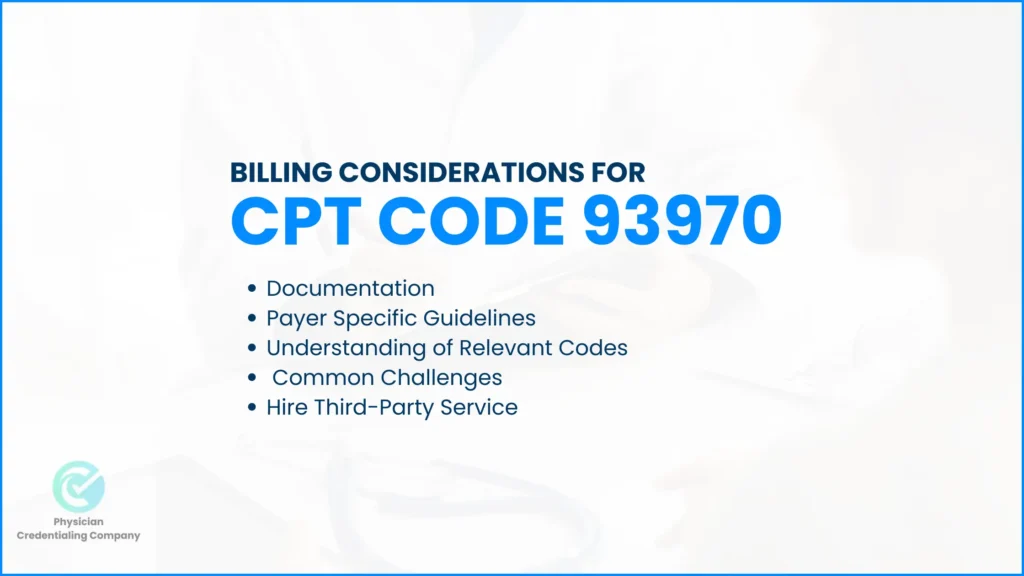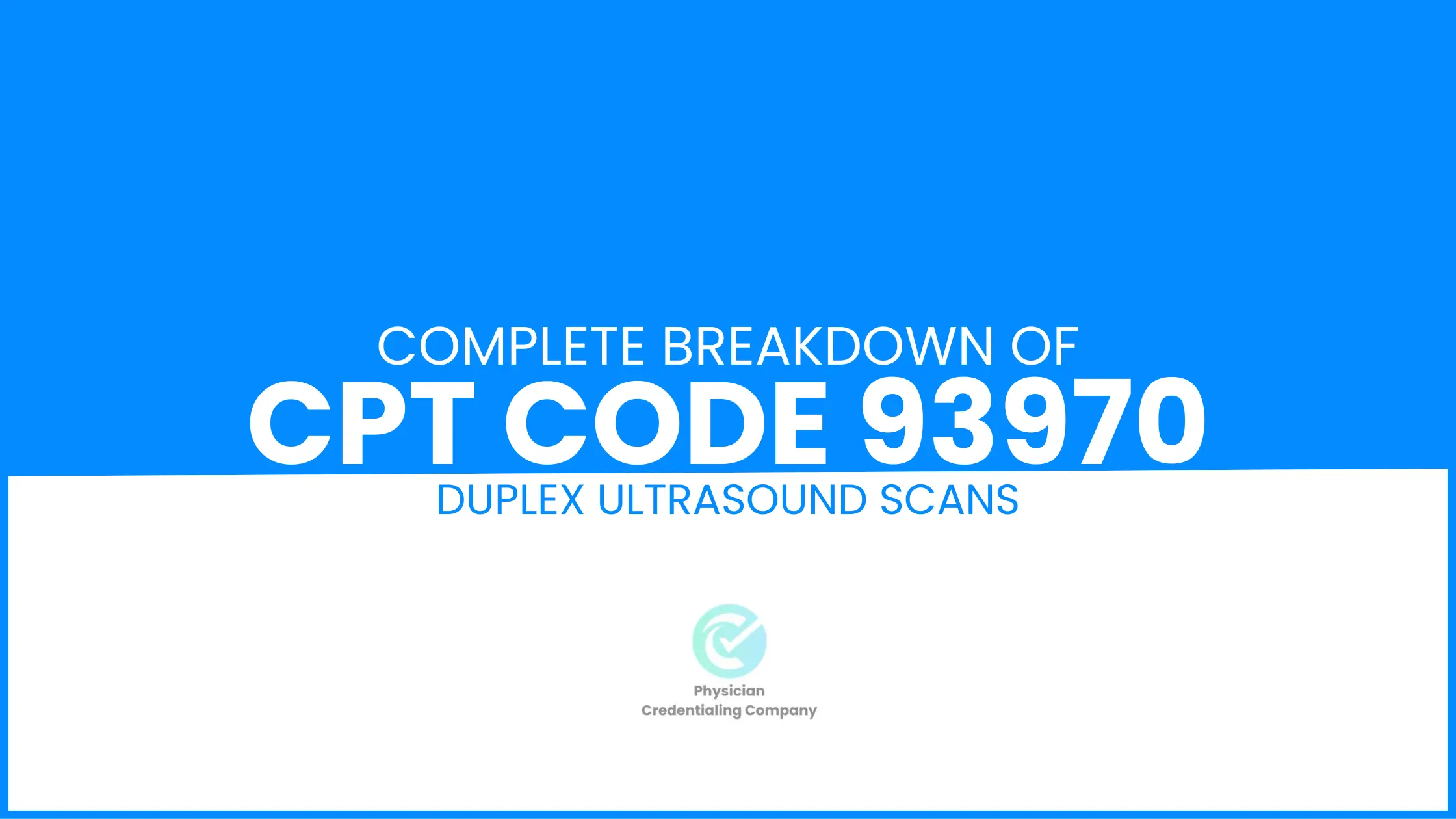CPT codes hold a significant place in medical billing and coding. All patient care services, i.e., diagnostic, therapeutic, or management services, are represented by their specific codes in the medical bills. CPT codes act as a universal language, bridging the gap between providers, payers, and patients.
With the introduction of CPT codes in the bills rather than the traditional full description of medical services, fraudulent activities and disputes are avoided to an extent. In the cardiovascular system, physicians need to assess the condition of peripheral veins and arteries using different techniques for ailment evaluation (Read about the coding changes in Cardiology Billing here). A duplex ultrasound scan specified by CPT code 93970 is a useful technique for venous evaluation.
In this article, we will learn the description of CPT code 93970 and the medical indications of its use. We will also learn about billing considerations and challenges for code 93970.
93970 CPT Code Description
Before delving deep into the medical billing of 93970, it is important to understand what CPT code 93970 is. Code 93970 refers to a duplex ultrasound scan to assess the functional and structural parameters of lower extremity veins. It includes two traditional techniques known as ultrasound and Doppler.
It is a non-invasive test to check extremity veins when patients present with symptoms like leg swelling and pain. It also supports compression and other measures to check the response of veins. Functional parameters like blood flow, velocity, and direction are checked. The structure of the veins can also be assessed by duplex ultrasound. Below are a few medical indications which need use of the 93970 CPT code:
- Deep Vein Thrombosis: Patients with leg swelling, redness, and pain may have clots in the veins. Duplex ultrasound helps visualize clots, if any.
- Varicose Veins: These veins bulge and are large due to some structural defects causing valve reflux. Structural and functional patterns of varicose veins are evaluated.
- Venous Insufficiency: A blood flow assessment is made to check the severity of venous reflux. This can help to diagnose the root cause of venous reflux.
- Pre-Surgical Mapping: In grafting surgeries like bypass, veins are taken from the lower extremities. Veins are assessed before taking a graft using duplex ultrasound.
- Post-Surgical Evaluation: In surgeries like venous stenting or stripping, veins can be checked.
CPT Code 93970 Procedure Details
A duplex ultrasound, as specified by 93970, contains an ultrasound and doppler for vein evaluation and assessment. Patients should be informed about the procedure, and consent should be obtained. In this process, the gel is applied over the skin where doctors wish to check the underlying vein. A compression meander is performed to check the severity of the reflux. The transducer is moved over the vessel to record the blood flow and other parameters. The dopplex technique helps check the velocity, flow direction, and clots in the blood vessels. Diagnosis can be made on the basis of the result report.
This method has many advantages. It is non-invasive and done without any anesthesia. There is no pain associated with the procedure, and real-time results are obtained. Sound waves are used instead of radiation, which allows multiple attempts without any risk factor.
Billing Considerations for CPT Code 93970

Documentation
Documentation is very necessary for effective billing and audits. Documentation should be performed from start to end. The reason for patient presentation, history details, examination performed, duplex ultrasound details, medical indications, results, and everything else need to be noted. Documentation helps to justify the use of the 93970 code in the medical bills. Insurance companies ask for documentation in the submitted claims.
Payer Specific Guidelines
Payers like Medicare or commercial insurance companies have their own guidelines regarding the billing of 93970. It is wise to understand the guidelines thoroughly before starting medical billing. Many payers, such as Medicare, have a pre-authorization requirement for duplex ultrasounds as they are costly procedures. Providers need to submit the medical necessity report and ask for permission.
They can submit claims for duplex ultrasound by attaching permission notification. Without following proper guidelines, there are high chances of claim denial or rejection. To avoid potential revenue leaks, motivate billers and providers to stay updated with billing guidelines.
Understanding of Relevant Codes
It is also important to understand other CPT codes that are related to duplex ultrasound. 93971 also bills this technique, but how does it differ from 93970? In the 93970 CPT code description, it is clearly mentioned that it is used for bilateral assessment of veins as both limbs will be assessed. While CPT code 93971 bills for limited or unilateral duplex ultrasound technique.
Common Challenges
CPT codes referring to technological procedures are always difficult to handle. Providers and billers have to face challenges like compliance issues, errors, documentation, new policies, and claim denials. For billing 93970, medical necessity denial is the main problem. The medical necessity of duplex ultrasound is complicated, and expert providers should be needed at the payer’s end to see its importance. Most often, payers reject the pre-authorization application, and permission is not granted. This results in frustration and delays in executing the management plan. Patient health can be compromised.
Other potential challenges are upcoding or undercoding. This happens when billers are not educated enough to understand the difference between two codes like 93970 or 93971. If 93970 is assigned in place of 93971, it results in a claim submission for a higher code. Such upcoding activity can be considered fraud, and providers may have to bear legal proceedings.
The healthcare industry is ever-evolving, and to enhance industry standards, new regulations are introduced on and off. Providers need to remain compliant with billing regulations. Otherwise, claim denials will become routine. This is a common challenge, as staying up-to-date with each guideline is daunting because of multiple other duties.
Healthcare and billing experts provide some insight into how to solve these issues. Hiring expert billers for in-house billing, regular audits, and motivating providers to attend educational seminars can be useful for smooth billing.
Hire Third-Party Service
Hiring third-party service providers is the best practice if you want to grow financially as a healthcare facility. Third-party providers reduce the administrative burden, and healthcare providers can focus on patient care. They are experts in billing and know the common billing trends. Billing errors are rectified to streamline the billing operation. Third-party providers can also manage large volume claims in a short time, which allows physicians to provide medical services to a large number of patients.
Conclusion
What is CPT code 93970? This code refers to the duplex ultrasound, which is performed to assess the functional and structural integrity of lower extremity vessels. A few medical indications, such as venous thrombosis, pre-surgical evaluation, post-surgical follow-up, and varicose veins, are mentioned in the CPT code 93970 description. In this procedure, the gel is applied at the desired site, and an ultrasound transducer is moved, which records the blood flow and structural anomalies of the vessels. Diagnosis and further management plans can be made on the basis of results.
This technique is less invasive and risk-free. A few billing considerations should be kept in mind while billing for 93970. Billers need to follow the payer’s guidelines, like pre-authorization and compliance rules. The difference between 93970 and 93971 is compulsory to understand for accurate billing. Challenges like errors, compliance, and high billing costs can be resolved by training staff. Hiring a third party is also a good option for a smooth billing process and reducing administrative burden.
FAQ - People Also Asks
No, both codes are different, and they are billed separately. 93970 bills for bilateral assessment by duplex ultrasound, while unilateral scans are billed with 93971. For a complete understanding of billing rules, providers need to check the payer-specific guidelines for accurate billing.
The reimbursement rate for every CPT code depends on the type of payer and geographical location. Each payer has a different cost depending on the living cost of a certain area and the expertise of the healthcare provider. On average, a duplex ultrasound for a bilateral scan costs up to $70.
It is a special ultrasound that is used to check the blood flow in vessels in the abdomen, arms, neck, or legs. It is performed by an experienced sonographer with the assistance of a radiologist.
It depends on the type of payer with whom providers have to submit claims. Many payers, such as Medicare, need pre-authorization before going for a duplex ultrasound. Providers need to check payer guidelines and follow them.

